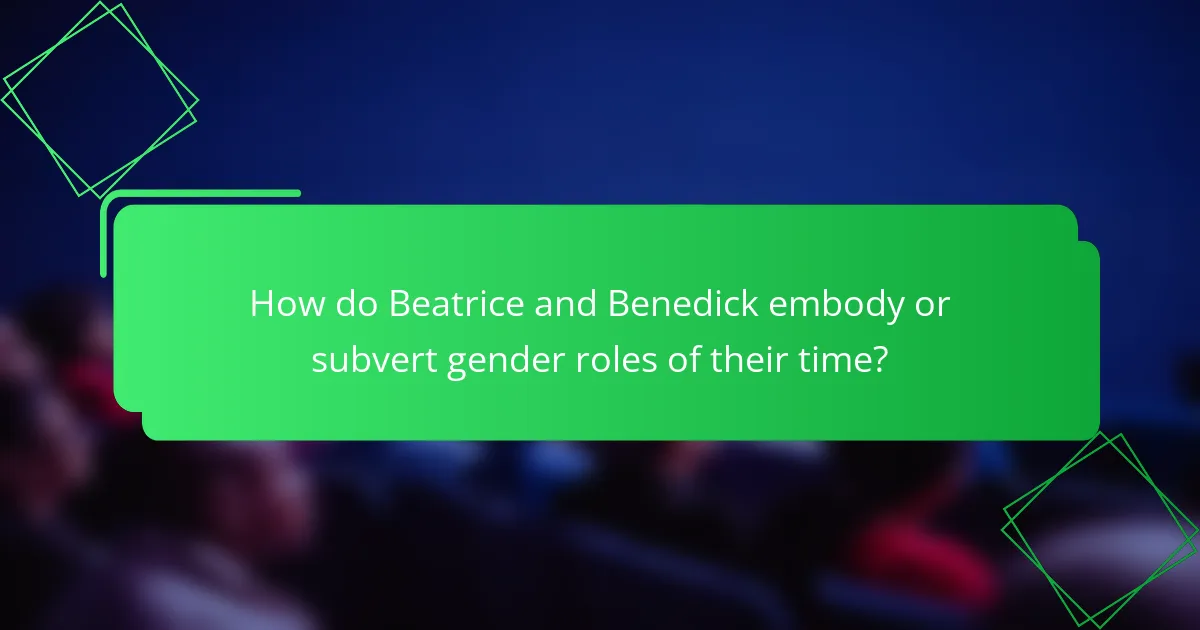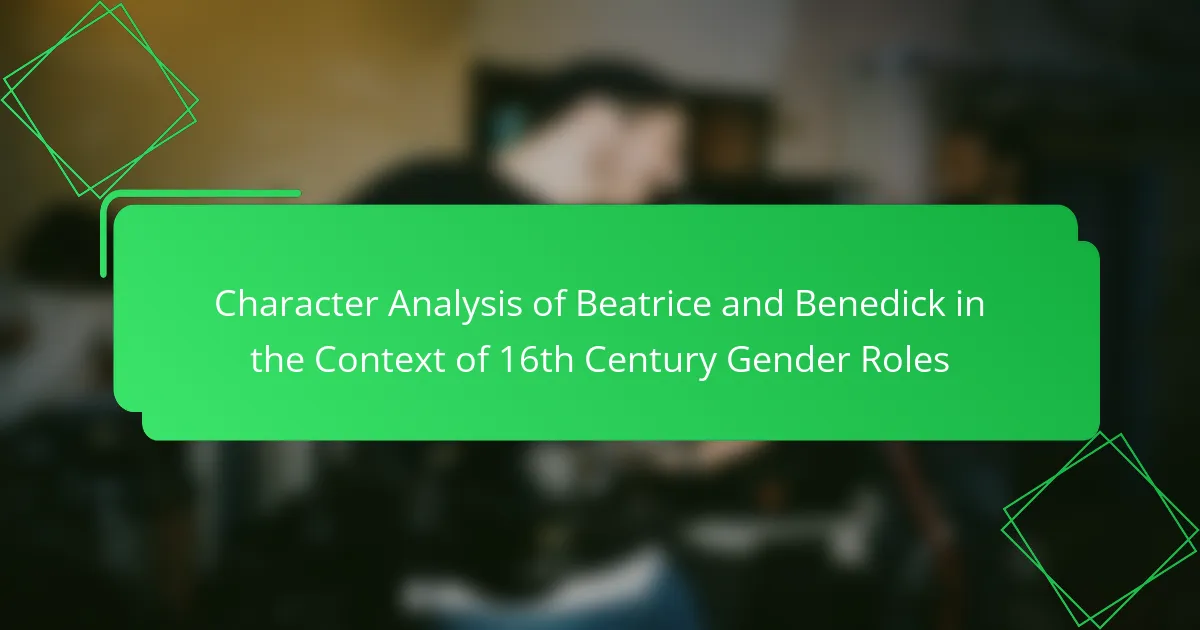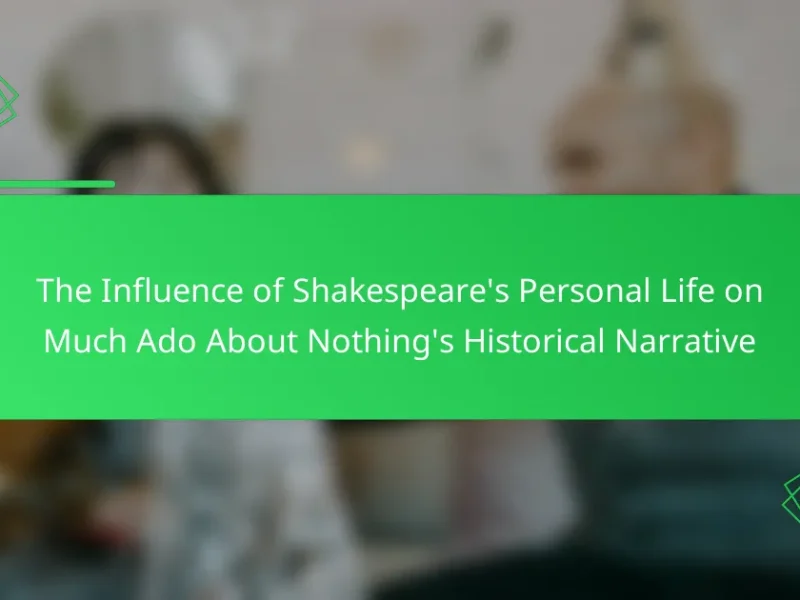
What are the key characteristics of Beatrice and Benedick in the play?
Beatrice and Benedick are characterized by their wit and strong personalities. Both engage in sharp banter, showcasing their intelligence and independence. Beatrice is outspoken and challenges societal norms, often critiquing gender roles. Benedick displays a similar rebellious spirit, resisting traditional expectations of masculinity. Their relationship evolves from playful antagonism to mutual respect and love. This transformation reflects their compatibility and growth. Ultimately, their dynamic serves as a commentary on love and gender in the 16th century.
How do Beatrice and Benedick’s personalities reflect 16th-century gender roles?
Beatrice and Benedick’s personalities illustrate 16th-century gender roles through their interactions and societal expectations. Beatrice embodies the challenges to traditional femininity. She is outspoken, witty, and independent, defying the submissive role expected of women. Benedick, in contrast, represents the masculine ideal of the time. He is assertive and values honor, reflecting societal expectations for men to be dominant. Their banter highlights the tension between these roles. Beatrice’s desire for equality in love contrasts with Benedick’s initial reluctance to embrace vulnerability. This dynamic showcases the limitations imposed by their gender roles. Their eventual union suggests a negotiation of these roles, blending individuality with societal norms.
In what ways do their dialogues reveal their views on love and marriage?
Beatrice and Benedick’s dialogues reveal their views on love and marriage through wit and skepticism. Their banter often reflects a critical stance toward traditional romantic ideals. Beatrice frequently challenges societal norms, expressing independence and disdain for conventional marriage. For instance, she asserts that she would rather remain single than conform to the expectations of a submissive wife. Benedick, on the other hand, initially mocks the institution of marriage, claiming he will never marry. However, his dialogue evolves, showing a gradual acceptance of love’s complexities. Their interactions highlight a tension between personal desires and societal pressures. Ultimately, their dialogues illustrate a journey from cynicism to a more nuanced understanding of love and partnership.
How does their wit and banter challenge traditional gender expectations?
Beatrice and Benedick’s wit and banter challenge traditional gender expectations by subverting conventional roles. Beatrice exhibits assertiveness and independence, traits often reserved for men in the 16th century. She openly critiques male authority and societal norms, which defies the expected submissive female behavior. Benedick, in turn, engages in playful repartee, showcasing vulnerability and emotional depth, typically associated with femininity. Their exchanges reveal a partnership based on equality and mutual respect, contrasting with the hierarchical dynamics of their time. This dynamic illustrates that intelligence and humor are not confined to one gender, promoting a more progressive view of relationships. Their interactions serve as a commentary on the rigid gender norms of the era, suggesting that both men and women can possess qualities traditionally assigned to the opposite gender.
What are the significant themes surrounding Beatrice and Benedick’s relationship?
The significant themes surrounding Beatrice and Benedick’s relationship include wit, love, and gender dynamics. Their relationship is characterized by a battle of wits. Beatrice and Benedick engage in sharp, playful banter. This reflects their intelligence and independence. Their initial reluctance to express love highlights societal expectations of the 16th century. They challenge traditional gender roles by valuing mutual respect and equality. Ultimately, their relationship evolves from antagonism to genuine affection. This transformation underscores the theme of love conquering pride. Their union represents a progressive view of partnership in a patriarchal society.
How does their relationship evolve throughout the play?
Beatrice and Benedick’s relationship evolves from mutual disdain to deep affection throughout the play. Initially, they engage in witty banter and challenge each other’s views. Their interactions reflect the societal norms of 16th-century gender roles, where both characters assert their independence. As the plot progresses, their friends conspire to bring them together. This manipulation leads to a shift in their feelings, revealing their true affections. By the end of the play, they express love and commitment, showcasing a transformation from antagonism to partnership. Their relationship ultimately subverts traditional gender expectations, illustrating a more egalitarian dynamic.
What role does societal pressure play in their interactions?
Societal pressure significantly influences Beatrice and Benedick’s interactions. In the context of 16th century gender roles, societal expectations dictate behavior and relationships. Beatrice exhibits independence and wit, challenging traditional female roles. Benedick, on the other hand, grapples with masculine ideals of honor and strength. Their banter reflects societal norms, as both characters navigate expectations of courtship and marriage. The pressure to conform affects their initial reluctance to express true feelings. Ultimately, societal pressure serves as a catalyst for their transformation. Their eventual union symbolizes a reconciliation of personal desires with societal expectations.

How do Beatrice and Benedick embody or subvert gender roles of their time?
Beatrice and Benedick subvert traditional gender roles of the 16th century. Beatrice exhibits traits typically associated with masculinity, such as wit and assertiveness. She openly challenges societal norms by rejecting the expectation of female submission. Benedick, on the other hand, displays vulnerability and emotional depth, traits often reserved for women. Their banter reflects a partnership that defies the conventional power dynamics of their time. For instance, Beatrice’s famous line, “I had rather hear my dog bark at a crow than a man swear he loves me,” illustrates her independence and refusal to conform. Benedick’s eventual willingness to express love and commitment also challenges male stereotypes. Together, they embody a more egalitarian relationship, showcasing mutual respect and intellectual equality. Their interactions highlight a critique of the rigid gender expectations prevalent in their society.
What societal norms do Beatrice and Benedick confront?
Beatrice and Benedick confront the societal norms of 16th-century gender roles. They challenge the expectation that men should dominate in relationships. Beatrice defies the norm by expressing her opinions openly. She rejects the idea that women should be submissive and silent. Benedick also resists the pressure to conform to traditional masculinity. He values wit and intelligence over mere bravado. Their relationship subverts the conventions of courtship and marriage. They prioritize mutual respect and understanding over societal expectations. This dynamic reflects a progressive view on gender equality for their time.
How does Beatrice’s character challenge the submissive role expected of women?
Beatrice’s character challenges the submissive role expected of women through her assertiveness and wit. She openly expresses her opinions and desires, defying societal norms. Beatrice frequently engages in sharp banter with male characters. This demonstrates her refusal to adhere to traditional female passivity. She mocks the expectations placed upon women, showcasing her independence. For instance, she boldly declares her disdain for marriage. Her refusal to conform is evident in her interactions with Benedick. Beatrice’s character ultimately embodies a progressive view of women’s roles in her society.
In what ways does Benedick’s behavior reflect or defy masculine ideals?
Benedick’s behavior reflects masculine ideals through his wit and self-assuredness. He demonstrates confidence in his interactions with others. His banter with Beatrice showcases traditional male assertiveness. Benedick also values honor and loyalty among friends, aligning with masculine codes of conduct. However, he defies some ideals by expressing vulnerability and emotional depth. His eventual willingness to commit to Beatrice challenges the notion of emotional stoicism in men. Benedick’s transformation throughout the play illustrates a nuanced approach to masculinity. This complexity highlights the tension between societal expectations and personal authenticity.
What is the significance of their relationship within the context of the play?
The significance of Beatrice and Benedick’s relationship within the context of the play lies in its challenge to traditional gender roles. Their witty banter and mutual respect highlight a partnership based on equality. This dynamic contrasts sharply with the expectations of 16th-century society, where women were often subservient. Beatrice’s assertiveness and Benedick’s willingness to embrace vulnerability illustrate a progressive view of love. Their relationship ultimately subverts societal norms, showcasing a more modern approach to romance. This significance is evident as their interactions provide commentary on the limitations placed on both genders during that era.
How does their union comment on the institution of marriage in the 16th century?
Beatrice and Benedick’s union critiques the institution of marriage in the 16th century by showcasing a relationship based on mutual respect and wit. Their dynamic challenges traditional gender roles prevalent during that era. Unlike typical marriages of the time, which often emphasized male dominance, their partnership highlights equality. Beatrice’s assertiveness and Benedick’s willingness to engage in banter illustrate a departure from conventional expectations. This reflects a broader commentary on the evolving nature of marriage. Their relationship suggests that love can thrive on companionship rather than mere social obligation. Their union ultimately advocates for a more progressive view of marriage, emphasizing partnership over hierarchy.
What insights do Beatrice and Benedick provide about love and partnership?
Beatrice and Benedick provide insights into love and partnership by showcasing a relationship based on mutual respect and intellectual equality. Their witty banter reveals a deep understanding of each other’s strengths and weaknesses. They challenge traditional gender roles of the 16th century, portraying a partnership that values companionship over subservience. Their initial reluctance to admit love highlights the complexities of romantic relationships. Ultimately, their union symbolizes a modern approach to love, emphasizing choice and compatibility. Their interactions demonstrate that love can thrive in an environment of honesty and playfulness. This dynamic relationship contrasts with other couples in the play, reinforcing their unique perspective on partnership.

What can we learn from Beatrice and Benedick’s character dynamics?
Beatrice and Benedick’s character dynamics reveal the complexities of love and gender roles in the 16th century. Their witty banter demonstrates intellectual equality and mutual respect. This challenges traditional gender norms of the time, which often positioned women as submissive. Beatrice asserts her independence, showcasing a strong female voice. Benedick’s evolution from a carefree bachelor to a committed partner highlights personal growth. Their relationship illustrates that love can thrive on friendship and respect. Their dynamics also reflect societal expectations and the tension between individual desires and social conventions. Ultimately, their interactions provide insight into the negotiation of power within romantic relationships during this era.
How do their interactions illustrate the complexities of gender roles?
Beatrice and Benedick’s interactions illustrate the complexities of gender roles by showcasing their defiance of societal expectations. Beatrice often challenges traditional female submissiveness through her wit and independence. She engages in banter with Benedick, asserting her opinions and desires openly. Benedick, in contrast, initially embodies the masculine ideal of detachment but evolves to embrace vulnerability. Their verbal sparring reflects the tension between societal norms and personal identity. This dynamic highlights the struggle for agency within rigid gender constructs of the 16th century. Their eventual union represents a negotiation of power, blending both assertiveness and affection. This complexity underscores the fluidity of gender roles, revealing that both characters navigate and redefine their identities.
What lessons can modern audiences draw from their relationship?
Modern audiences can draw lessons about the dynamics of gender roles from Beatrice and Benedick’s relationship. Their interactions challenge traditional expectations of masculinity and femininity. Beatrice embodies strength and independence, defying societal norms. Benedick, initially conforming to male stereotypes, evolves through his love for Beatrice. Their witty banter highlights the importance of mutual respect and equality in relationships. Their eventual union suggests that love can transcend societal constraints. This reflects contemporary values of partnership and collaboration. Their story encourages audiences to question and redefine gender roles in modern contexts.
What are some practical insights from analyzing Beatrice and Benedick?
Beatrice and Benedick exemplify the complexities of gender roles in the 16th century. Their witty banter challenges traditional expectations of courtship. Beatrice’s assertiveness contrasts with societal norms for women, who were often expected to be submissive. Benedick’s initial reluctance to commit reflects male anxieties about vulnerability. Their relationship evolves through mutual respect and intellectual equality. This dynamic offers insights into the negotiation of power in romantic relationships. Their eventual union symbolizes a balance between independence and partnership. Analyzing their characters reveals the potential for subverting gender norms.
How can their character traits inform contemporary discussions on gender equality?
Beatrice and Benedick’s character traits highlight the complexities of gender roles. Beatrice exhibits strong independence and wit, challenging traditional female expectations. This reflects contemporary discussions on women’s empowerment and autonomy. Benedick demonstrates vulnerability, subverting male stereotypes of stoicism. Their dynamic illustrates the importance of mutual respect and equality in relationships. These traits encourage dialogue about redefining gender norms today. Their interactions reveal that both men and women can benefit from breaking free of restrictive roles. This relevance fosters a deeper understanding of gender equality in modern society.
The main entity of the article is the character analysis of Beatrice and Benedick from a 16th-century perspective on gender roles. The article examines their witty interactions, which challenge traditional gender expectations, highlighting Beatrice’s assertiveness and Benedick’s evolving vulnerability. It discusses how their relationship evolves from antagonism to mutual respect, reflecting broader themes of love, partnership, and societal pressures. Additionally, the analysis provides insights into how their dynamics illustrate the complexities of gender roles and offer lessons relevant to contemporary discussions on gender equality.


